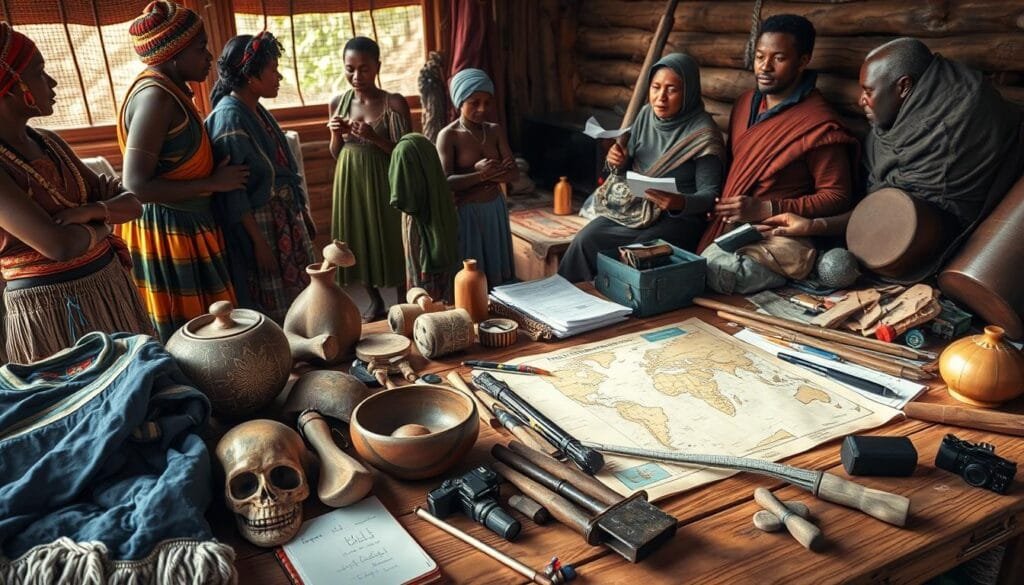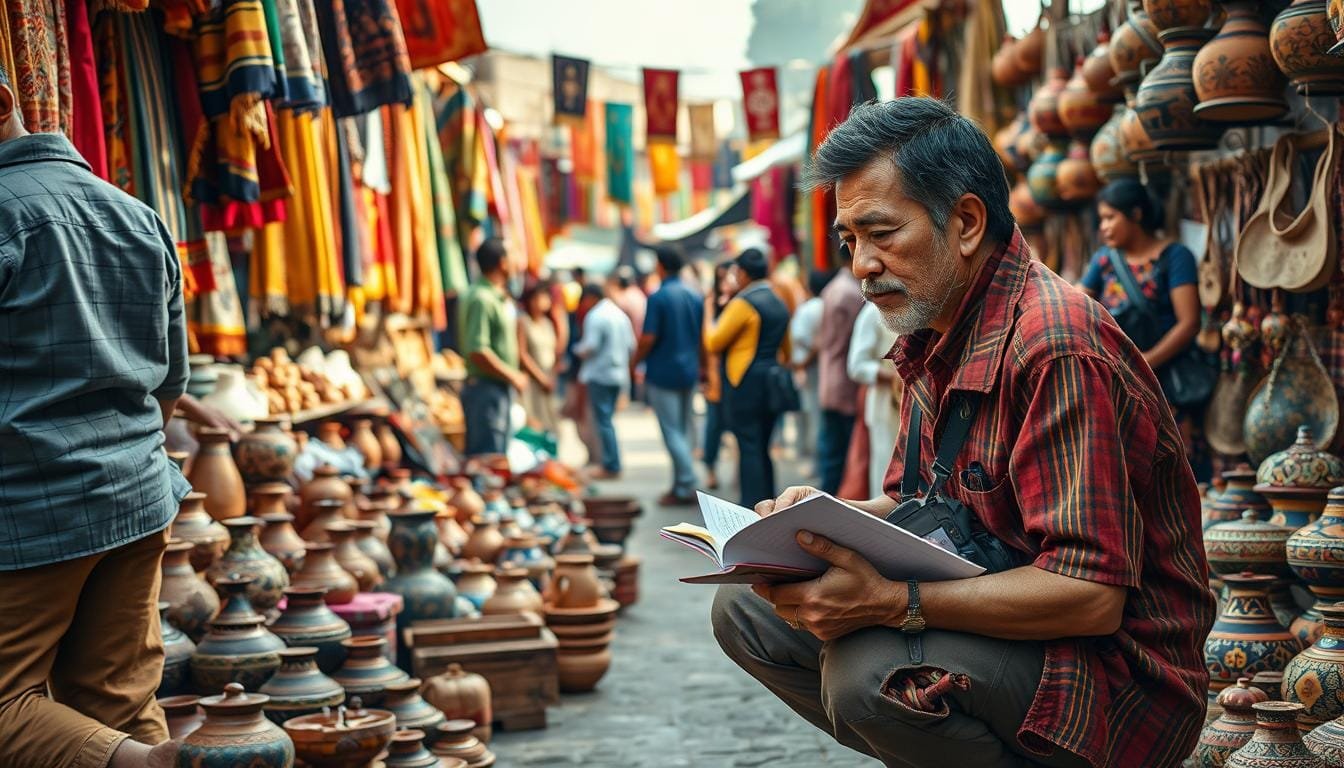Why do anthropologists spend years in unknown cultures, taking notes on everything? Their passion is key to cultural anthropology, giving us deep insights into human societies. But what exactly are they looking for in their field studies?
Understanding cultural anthropology starts with seeing how vital fieldwork and data are. From Bronislaw Malinowski’s early work to today, anthropologists use many methods to capture cultural dynamics. They use observation, interviews, focus groups, and surveys to collect data.
Malinowski showed us the importance of the little things in life. These small details help us understand how people really interact day to day. By living with people and joining their rituals, anthropologists get a detailed picture beyond just numbers.
The method of being part of a community’s daily life is crucial. It lets researchers experience the culture firsthand, which takes a lot of time but is very rewarding. With interviews and focus groups added, they get a complete view of a culture.
Key Takeaways
- Fieldwork data collection is central to cultural anthropology methods.
- Being part of local activities gives an inside look at cultures.
- Interviews and focus groups add depth to the data.
- Malinowski’s work shows the value of noting everyday life.
- Combining many methods helps understand cultures fully.
Participant Observation
Participant observation is a key research method in fields like cultural anthropology and sociology. It requires researchers to immerse themselves in the communities they study. By doing this, they can observe and participate in daily life and events.
This method was named in 1924 by Eduard C. Lindeman. It became popular through scholars like Frank Hamilton Cushing with the Zuni in the late 19th century. Other researchers, including Bronisław Malinowski and Margaret Mead, also used it to gain insights into various cultures.
The method is valued for reducing the gap between what people say and what they actually do. It allows anthropologists to see both obvious actions and subtle interactions. Researchers may spend months to years observing a community.
Howell, in 1972, explained that participant observation has four stages. These are building trust, diving into the field, recording data, and analyzing information. Researchers should also reflect on how their identity affects their observations.
Participant observation can uncover social dynamics that other methods might miss. Though it takes a lot of time, it’s key for gathering detailed insights. This deep dive helps in understanding complex social matters thoroughly.
| Key Researchers | Research Period | Key Contributions |
|---|---|---|
| Frank Hamilton Cushing | Late 19th Century | Zuni People Studies |
| Bronisław Malinowski | 1929 | Ethnographic Fieldwork |
| Margaret Mead | 1928 | Coming of Age in Samoa |
| E.E. Evans-Pritchard | 1940 | Studies in African Tribes |
This method needs a lot of time and care, especially in delicate situations. It often goes with interviews and casual talks to ensure accuracy. By getting closely involved with cultures, researchers achieve a detailed and faithful view of human behavior and social ties.
Interviews
Interviews are key for cultural anthropologists. They lead to deep talks that offer detailed, qualitative info. You’ll find two main kinds: structured interviews and unstructured interviews. Each has benefits and special uses in study.
Structured interviews use planned questions. This method helps keep answers consistent, which simplifies comparing information. They’re great for quickly collecting specific facts, especially when time is tight.

But unstructured interviews are different. They’re more laid-back, letting conversations unfold naturally. This can lead to surprising, insightful discoveries. For instance, anthropologist Philippe Bourgois discovered key social insights in East Harlem through these open talks.
Both interview types might need many sessions. This can result in lots of data to review. These details are not just about what was said. They also capture the setting, feelings, and subtle points of discussions. This is why such records are crucial for cultural studies.
For fieldwork, researchers blend these interviews with other methods like watching or filming people. This mix helps paint a fuller picture of the studied culture. Below, see a table that highlights the differences and best uses for structured versus unstructured interviews:
| Aspect | Structured Interviews | Unstructured Interviews |
|---|---|---|
| Flexibility | Low | High |
| Consistency | High | Varies |
| Depth of Insight | Medium | High |
| Time Efficiency | High | Low |
| Ideal for | Specific data points | Exploratory research |
Focus Groups and Surveys
Using Conducting Focus Groups and surveys is less common in anthropology. Yet, they offer valuable insights for specific cultural topics. Focus groups usually have six to eight participants. They help us understand group dynamics and societal trends.
Gathering several people to discuss topics lets us see a collective view. This might be missed in one-on-one interviews.
Surveys are less used in anthropology because they need people to be able to read. But, they play a key role in research that uses more than one method. Surveys come in different forms, like online, mailed, in-person, and phone interviews.
These methods help measure cultural aspects. They also generalize data from deep interviews to more people. This avoids the issue of small interview sample sizes.

Ethnographic surveys are special in our field. They make sure the cultural data we collect is accurate. They often include info about people’s age, sex, education, and income.
This way allows for descriptive and explanatory surveys. Descriptive ones detail phenomena, and explanatory ones explain variable relationships.
Standardized procedures make sure all participants answer the same questions. This makes the data reliable. Longitudinal surveys track changes over time. They collect data at different points, showing how cultures evolve.
Participant observation is still the most used method in anthropology. But, mixing in techniques like Conducting Focus Groups and surveys is very useful. It gives us a full picture of cultural practices and behaviors.
What Data Do Cultural Anthropologists Collect
Cultural anthropologists work hard to gather detailed cultural data. They use different methods to fully understand communities. Their research can last from a few months to many years. It often takes place at one field site in regions like Latin America, Africa, Asia, and Oceania.

They focus on social structures, language, customs, and economy. The data shows how a community lives and interacts locally and globally.
They often do participant observation. They join in daily activities such as herding or disaster prevention. This helps them see the community’s dynamics from the inside. It’s about being part of the community, not just watching.
“Efforts to understand contemporary issues like mental health in Indonesia, policing in Kenya, and waste management in Hong Kong highlight the flexibility and relevance of cultural anthropology in addressing diverse societal challenges.”
Latest trends in anthropological research outcomes include global commodity chains and social media studies. They also look at how global issues like climate change affect local communities. This shows how cultural anthropology helps understand today’s complex world.
Recently, researchers focus on technology’s impacts, such as cellphones and artificial intelligence. Roughly 50% of anthropologists study these areas today. The COVID-19 pandemic has also led to studies on changes in education and cultural practices.
The outputs of anthropological research now often involve working with communities. This makes the research inclusive and thorough. Working together also addresses wrongs and power imbalances affecting marginalized groups.
By using both old and new methods, cultural anthropologists learn a lot about human diversity and society. They uncover insights and help us appreciate different cultures around the world.
| Region | Research Focus | Methods | Outcomes |
|---|---|---|---|
| Latin America | Social Structures | Participant Observation | Enhanced Community Dynamics Understanding |
| Africa | Mental Health | Interviews | Community Health Improvement |
| Oceania | Customs & Rituals | Focus Groups | Preservation of Cultural Heritage |
| Global | Technology’s Impact | Surveys | Understanding Technological Evolution |
Conclusion
Cultural anthropologists use important tools to better understand global cultures. They employ methods like observing, interviewing, and surveys to gather deep insights. Katherine Dettwyler’s study in Mali on child malnutrition is a perfect example. She shows how ethnography goes beyond simply describing to include detailed data gathering and analysis. Nutritional anthropologists document eating habits and health metrics to provide clear, usable results.
The way ethnographic fieldwork is defined has grown. Now, studies take place in cities and online, showing how cultures change with movement and migration. This new approach is captured in multi-sited ethnographies. These studies show how cultural practices are not fixed but flow and change. They underscore the importance of context in understanding different cultures, as Munroe and others’ comparative research illustrates.
Anthropological research must be ethical. Building trust through observation takes time and sensitivity. This careful work makes sure the collected data is respectful and accurate. Furthermore, the influence of this research reaches beyond just academic study. It helps us appreciate cultural diversity, leading to a more empathetic society and inclusive discussions. Whether using GPS to map Native lands or studying how work conditions affect productivity, these studies add to our ongoing global dialogue.
FAQ
What is participant observation in cultural anthropology?
A: Participant observation is key in cultural anthropology. Researchers join a culture’s daily life to understand it better. They watch and engage closely to catch the fine details of traditions.
How do structured interviews benefit cultural anthropological research?
Structured interviews help by giving uniform answers. Researchers use specific questions to learn about cultures. This makes comparing data from different sources more straightforward.
What are the differences between structured and unstructured interviews?
Structured interviews have fixed questions, providing reliable data. Unstructured interviews, on the other hand, let conversations flow naturally. This can lead to discovering unexpected truths about a culture.
Are focus groups commonly used in cultural anthropology?
Focus groups aren’t the go-to method, but they’re valuable. They shine a light on how groups within a culture think. This helps in understanding common views and social patterns.
What role do surveys play in anthropological research?
Surveys map out cultural habits, showing big-picture trends. But they work best where people can easily access and understand them. When this isn’t the case, anthropologists must find new ways to gather info.
What types of data do cultural anthropologists collect during fieldwork?
During fieldwork, anthropologists collect lots of data. They look at everyday life, food rituals, and how people interact. They also use interviews, focus groups, and surveys. All this helps build a full picture of a culture.
Why is participant observation considered a crucial technique in ethnographic research?
Participant observation is vital for deep cultural understanding. It lets anthropologists experience a culture’s complexity first-hand. They get to see things that might be missed otherwise.
